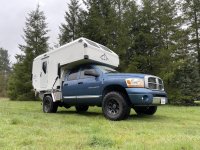I did a quick search and didn't see any topics on this... but is there a general consensus of why flatbed campers cost so much more (generally thousands!) than an otherwise equivalent slide-in camper? Some specific examples are the the hawk from four wheel campers... a basic config of the slide-in costs $11k LESS than a similar config of the flatbed (~$26.6k vs ~$38k). If you go the kit route from a company like bison overland a bare slide in costs $6k less than the equivalent flatbed ($17.5k vs $23.5k).
Objectively, from a pure labor and materials standpoint I expect the flatbed to actually be CHEAPER (for the same size camper). There are fewer edges and panels to cut, and you don't need as compicated of fixturing/jig to hold the parts. If you're using prefab wall panels then the total surface area of the panels remains the same (interior volume is less for the slide in) but the "notches" on the slide-in camper add at least four extra edges so you consume more of your edge material (extruded aluminum, filastruted fiberglass, whatever) as well as adhesives/fasteners and you have to add structural support for the new horizontal surfaces so the "box" will hold its shape.
Does the pricing really just come down to the interior volume (flatbed will always be a roomier camper) and the "cool factor" of the flatbed? I'm a capitalist through and through so I have no problem if the pricing is simply "what the market will bear" but it seems kinda strange to me. Especially when you consider the extra costs of upfitting the truck with a flatbed before you even buy the camper!
Sorry, didn't mean to be a rant... just curious if anyone has seen any explanation for this phenomenom... or maybe some flatbed owners explaining why they were willing to pay more.
Objectively, from a pure labor and materials standpoint I expect the flatbed to actually be CHEAPER (for the same size camper). There are fewer edges and panels to cut, and you don't need as compicated of fixturing/jig to hold the parts. If you're using prefab wall panels then the total surface area of the panels remains the same (interior volume is less for the slide in) but the "notches" on the slide-in camper add at least four extra edges so you consume more of your edge material (extruded aluminum, filastruted fiberglass, whatever) as well as adhesives/fasteners and you have to add structural support for the new horizontal surfaces so the "box" will hold its shape.
Does the pricing really just come down to the interior volume (flatbed will always be a roomier camper) and the "cool factor" of the flatbed? I'm a capitalist through and through so I have no problem if the pricing is simply "what the market will bear" but it seems kinda strange to me. Especially when you consider the extra costs of upfitting the truck with a flatbed before you even buy the camper!
Sorry, didn't mean to be a rant... just curious if anyone has seen any explanation for this phenomenom... or maybe some flatbed owners explaining why they were willing to pay more.



